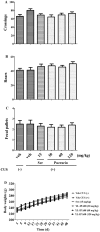Puerarin ameliorated the behavioral deficits induced by chronic stress in rats
- PMID: 28740098
- PMCID: PMC5524961
- DOI: 10.1038/s41598-017-06552-x
Puerarin ameliorated the behavioral deficits induced by chronic stress in rats
Abstract
The present study aimed to investigate the mechanisms underlying the antidepressant-like effects of puerarin via the chronic unpredictable stress (CUS) procedure in rats. Similar to Sertraline (Ser), Chronic treatment of puerarin (60 and 120 mg/kg, i.g) elicited the antidepressant-like effects by reversing the decreased sucrose preference in sucrose preference test (SPT), by blocking the increased latency to feed in novelty-suppressed feeding test (NSFT) and the increased immobility time in forced swimming test (FST) without affecting locomotor activity. However, acute puerarin treatment did not ameliorate the antidepressant- and anxiolytic- like effects in FST and NSFT, respectively. In addition, enzyme linked immunosorbent assay (ELISA) and high performance liquid chromatography-electrochemical detection (HPLC-ECD) showed that chronic treatment of puerarin (60 and 120 mg/kg, i.g) reversed the decreased levels of progesterone, allopregnanolone, serotonin (5-HT) and 5-Hydroxyindoleacetic acid (5-HIAA) in prefrontal cortex and hippocampus of post-CUS rats. Furthermore, puerarin (60 and 120 mg/kg, i.g) blocked the increased corticotropin releasing hormone (CRH), corticosterone (Cort) and adrenocorticotropic hormone (ACTH). Collectively, repeated administration of puerarin alleviated the behavioral deficits induced by chronic stress which was associated with the biosynthesis of neurosteroids, normalization of serotonergic system and preventing HPA axis dysfunction.
Conflict of interest statement
The authors declare that they have no competing interests.
Figures








Similar articles
-
The anxiolytic-like effects of ginsenoside Rg3 on chronic unpredictable stress in rats.Sci Rep. 2018 May 17;8(1):7741. doi: 10.1038/s41598-018-26146-5. Sci Rep. 2018. PMID: 29773855 Free PMC article.
-
The anxiolytic-like effects of puerarin on an animal model of PTSD.Biomed Pharmacother. 2019 Jul;115:108978. doi: 10.1016/j.biopha.2019.108978. Epub 2019 May 16. Biomed Pharmacother. 2019. PMID: 31102911
-
Antidepressant-like effect of geniposide on chronic unpredictable mild stress-induced depressive rats by regulating the hypothalamus-pituitary-adrenal axis.Eur Neuropsychopharmacol. 2015 Aug;25(8):1332-41. doi: 10.1016/j.euroneuro.2015.04.009. Epub 2015 Apr 17. Eur Neuropsychopharmacol. 2015. PMID: 25914157
-
Crassifoside H improve the depressive-like behavior of rats under chronic unpredictable mild stress: Possible involved mechanisms.Brain Res Bull. 2017 Oct;135:77-84. doi: 10.1016/j.brainresbull.2017.09.015. Epub 2017 Sep 29. Brain Res Bull. 2017. PMID: 28970041
-
JIEYUANSHEN DECOCTION EXERTS ANTIDEPRESSANT EFFECTS ON DEPRESSIVE RAT MODEL VIA REGULATING HPA AXIS AND THE LEVEL OF AMINO ACIDS NEUROTRANSMITTER.Afr J Tradit Complement Altern Med. 2017 Jan 13;14(2):33-46. doi: 10.21010/ajtcam.v14i2.5. eCollection 2017. Afr J Tradit Complement Altern Med. 2017. PMID: 28573220 Free PMC article.
Cited by
-
Pathogenesis of depression and the potential for traditional Chinese medicine treatment.Front Pharmacol. 2024 Jun 25;15:1407869. doi: 10.3389/fphar.2024.1407869. eCollection 2024. Front Pharmacol. 2024. PMID: 38983910 Free PMC article. Review.
-
Traditional Chinese Medicine in Depression Treatment: From Molecules to Systems.Front Pharmacol. 2020 May 7;11:586. doi: 10.3389/fphar.2020.00586. eCollection 2020. Front Pharmacol. 2020. PMID: 32457610 Free PMC article. Review.
-
Extracellular Vesicles: Emerging Roles in Developing Therapeutic Approach and Delivery Tool of Chinese Herbal Medicine for the Treatment of Depressive Disorder.Front Pharmacol. 2022 Mar 24;13:843412. doi: 10.3389/fphar.2022.843412. eCollection 2022. Front Pharmacol. 2022. PMID: 35401216 Free PMC article. Review.
-
Antidepressant-like effects of Z-ligustilide on chronic unpredictable mild stress-induced depression in rats.Exp Ther Med. 2021 Jul;22(1):677. doi: 10.3892/etm.2021.10109. Epub 2021 Apr 25. Exp Ther Med. 2021. PMID: 33986842 Free PMC article.
-
Screening and Identification of Antidepressant Active Ingredients from Puerariae Radix Extract and Study on Its Mechanism.Oxid Med Cell Longev. 2021 Sep 9;2021:2230195. doi: 10.1155/2021/2230195. eCollection 2021. Oxid Med Cell Longev. 2021. Retraction in: Oxid Med Cell Longev. 2024 Jan 9;2024:9756581. doi: 10.1155/2024/9756581. PMID: 34539968 Free PMC article. Retracted.
References
Publication types
MeSH terms
Substances
LinkOut - more resources
Full Text Sources
Other Literature Sources
Medical
Miscellaneous

